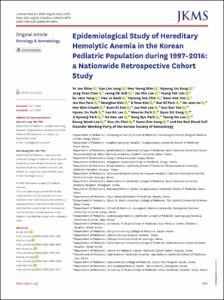Epidemiological Study of Hereditary Hemolytic Anemia in the Korean Pediatric Population during 1997–2016: a Nationwide Retrospective Cohort Study
- Keimyung Author(s)
- Shim, Ye Jee
- Department
- Dept. of Pediatrics (소아청소년학)
- Journal Title
- Journal of Korean Medical Science
- Issued Date
- 2020
- Volume
- 35
- Issue
- 33
- Keyword
- Congenital Hemolytic Anemia; Hereditary Spherocytosis; Hemoglobinopathies; Thalassemia; Glucose-6-phosphate Dehydrogenase Deficiency; Pyruvate Kinase
- Abstract
- Background:
Hereditary hemolytic anemia (HHA) is a rare disease characterized by premature red blood cell (RBC) destruction due to intrinsic RBC defects. The RBC Disorder Working Party of the Korean Society of Hematology established and updated the standard operating procedure for making an accurate diagnosis of HHA since 2007. The aim of this study was to investigate a nationwide epidemiology of Korean HHA.
Methods:
We collected the data of a newly diagnosed pediatric HHA cohort (2007–2016) and compared this cohort's characteristics with those of a previously surveyed pediatric HHA cohort (1997–2006) in Korea. Each participant's information was retrospectively collected by a questionnaire survey.
Results:
A total of 369 children with HHA from 38 hospitals distributed in 16 of 17 districts of Korea were investigated. RBC membranopathies, hemoglobinopathies, RBC enzymopathies, and unknown etiologies accounted for 263 (71.3%), 59 (16.0%), 23 (6.2%), and 24 (6.5%) of the cases, respectively. Compared to the cohort from the previous decade, the proportions of hemoglobinopathies and RBC enzymopathies significantly increased (P < 0.001 and P = 0.008, respectively). Twenty-three of the 59 hemoglobinopathy patients had immigrant mothers, mostly from South-East Asia.
Conclusion:
In Korea, thalassemia traits have increased over the past 10 years, reflecting both increased awareness of this disease and increased international marriages. The enhanced recognition of RBC enzymopathies is due to advances in diagnostic technique; however, 6.5% of HHA patients still do not have a clear diagnosis. It is necessary to improve accessibility of diagnosing HHA.
- Keimyung Author(s)(Kor)
- 심예지
- Publisher
- School of Medicine (의과대학)
- Citation
- Ye Jee Shim et al. (2020). Epidemiological Study of Hereditary Hemolytic Anemia in the Korean Pediatric Population during 1997–2016: a Nationwide Retrospective Cohort Study. Journal of Korean Medical Science, 35(33), e279. doi: 10.3346/jkms.2020.35.e279
- Type
- Article
- ISSN
- 1598-6357
- Source
- https://jkms.org/search.php?where=aview&id=10.3346/jkms.2020.35.e279&code=0063JKMS&vmode=FULL
- Appears in Collections:
- 1. School of Medicine (의과대학) > Dept. of Pediatrics (소아청소년학)
- 파일 목록
-
-
Download
 oak-2020-0648.pdf
기타 데이터 / 1.6 MB / Adobe PDF
oak-2020-0648.pdf
기타 데이터 / 1.6 MB / Adobe PDF
-
Items in Repository are protected by copyright, with all rights reserved, unless otherwise indicated.